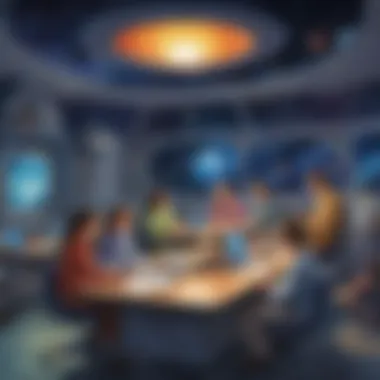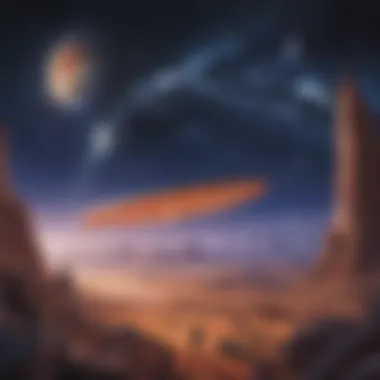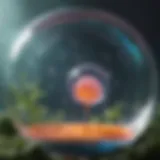Unlocking Cosmic Wonders: Space Projects for Young Explorers


Science Fun Facts
Delving into the captivating realm of space isn't just about stars and planets; there are numerous intriguing tidbits to uncover. For instance, did you know that the first living creatures sent into space were fruit flies aboard a U.S. V-2 rocket in 1947? This fascinating fact showcases the early beginnings of biological experiments beyond Earth's atmosphere. Another mind-boggling detail is that a day on Venus is longer than a year on Venus due to its extremely slow rotation! Such peculiarities make the study of space an endless source of wonder and curiosity.
Moving on to Quirky Science Stories, consider the tale of the Apollo 11 astronauts using duct tape to fix a broken CO2 filter. This impromptu repair job saved their mission, highlighting the importance of innovation and resourcefulness in space exploration. These anecdotes inspire creativity and problem-solving skills, essential qualities for any aspiring young scientist.
Transitioning to Amazing Science Records, behold the record for the longest continuous time in space held by Valeri Polyakov, who spent 437 days aboard the Mir space station. This extraordinary feat exemplifies the physical and mental endurance required for extended space missions. Such records push the boundaries of human potential and ignite curiosity about the capabilities of the human body in space.
Concluding with Thought-Provoking Questions, ponder on the possibility of life beyond Earth and its impact on our understanding of the universe. Consider how space exploration influences our daily lives and the innovations it brings. These questions stimulate critical thinking and encourage a deeper exploration of the mysteries that space holds for future generations.
Introduction
In the vast expanse of the universe, the realm of space education shines like a distant star, offering young minds a gateway to exploration and discovery. This article serves as a guiding light for students aged 6-12, illuminating the path to engaging space projects that fuel curiosity and inspire a passion for astronomy. By delving into the wonders of space through interactive activities and immersive experiences, young learners can embark on a journey that transcends the boundaries of Earth. Understanding the importance of space education is not merely about grasping scientific concepts but igniting a sense of wonder and fostering a spirit of inquiry that propels future generations towards the cosmos.
Understanding the Importance of Space Education
Exploring space is not just about rockets and planets; it's a voyage of knowledge and understanding that stretches the imagination of young explorers. Space education plays a pivotal role in nurturing critical thinking skills, sparking creativity, and cultivating a deep appreciation for the mysteries of the universe. Through hands-on experiments and virtual simulations, students gain practical insights into celestial phenomena, laying the foundation for a lifelong love of science. By immersing themselves in the intricacies of space exploration, young learners develop a holistic view of the cosmos and their place within it.
Hands-On Space Projects
In this section, we delve into the crucial realm of hands-on space projects geared towards young aspiring astronomers and scientists. Hands-on activities play a pivotal role in complementing theoretical knowledge with practical experience, fostering a deeper understanding of complex astronomical concepts. By engaging in hands-on projects, students aged 6-12 can cultivate a passion for space exploration while honing their problem-solving skills and scientific inquiry.
Building a Model Solar System


Building a model solar system serves as an exemplary hands-on activity to elucidate the positioning of planets and their orbits relative to the sun. This project not only enhances spatial awareness but also fosters creativity as students craft miniature versions of each celestial body. Through this exercise, children can grasp fundamental astronomical principles in a tactile and visually stimulating manner, providing a solid foundation for further astronomical pursuits.
Launching Water Bottle Rockets
The enthralling endeavor of launching water bottle rockets combines scientific principles with an element of fun and excitement. Students get hands-on experience with basic rocket propulsion technology by crafting their own rockets using simple materials like plastic bottles and water. This project stimulates curiosity, ignites an interest in physics, and encourages teamwork as students collaborate to achieve successful launches, emphasizing the significance of trial and error in the scientific process.
Designing and Testing Paper Rockets
Designing and testing paper rockets offer a cost-effective and accessible avenue for exploring aerodynamics and propulsion systems. Through this project, students delve into the intricacies of rocket design, testing different models to understand the impact of variables like nose cone shape and fin arrangement on flight performance. Not only does this activity bolster scientific thinking and problem-solving skills, but it also cultivates a sense of experimentation and innovation among young learners.
Constructing a Homemade Telescope
Constructing a homemade telescope amplifies the hands-on learning experience by enabling students to observe celestial objects up close. This project integrates basic optics principles as students assemble lenses or mirrors to create functional telescopes. By gazing at the night sky through their homemade instruments, children gain a profound appreciation for the vastness of the universe and the beauty of astronomical phenomena, fostering a sense of wonder and curiosity that fuels their interest in space exploration.
Virtual Space Exploration
Virtual space exploration plays a pivotal role in broadening the horizons of young students, igniting their curiosity and fostering a profound understanding of the cosmos. In this digital era, immersing students in virtual experiences opens a gateway to a universe of knowledge and innovation. By leveraging technology to simulate space environments and celestial phenomena, students can embark on voyages beyond the confines of Earth, expanding their awareness of the vast expanse that lies above. Virtual space exploration offers a dynamic platform for interactive learning, enabling students to visualize abstract concepts, such as planetary motion and cosmic phenomena, with remarkable clarity.
Participating in Online Astronomy Classes
Immersing oneself in online astronomy classes adds a new dimension to learning about the celestial realm. These virtual sessions provide a unique opportunity for young minds to delve into the intricacies of galaxies, stars, and planets, guided by seasoned astronomers and educators. Engaging in online astronomy classes stimulates critical thinking and scientific inquiry, encouraging students to ponder the mysteries of the cosmos and seek meaningful answers. By participating in these classes, students can expand their knowledge base, enhance their analytical skills, and cultivate a deep appreciation for the wonders of outer space.
Exploring Interactive Space Apps
Interactive space apps offer a hands-on approach to discovering the mysteries of the universe. These digital tools enable students to conduct virtual experiments, explore planetary surfaces, and simulate space missions with remarkable realism. By engaging with interactive space apps, young enthusiasts can interact with cutting-edge simulations, embark on virtual space expeditions, and unravel the complexities of celestial mechanics in a visually compelling manner. These apps serve as invaluable educational resources, sparking curiosity and nurturing a passion for space exploration among students of all ages.


Attending Virtual Planetarium Tours
Virtual planetarium tours transport young learners into a realm of celestial wonders, where they can gaze upon distant galaxies, nebulae, and star clusters from the comfort of their homes. These immersive experiences offer a glimpse into the vastness of the cosmos, allowing students to appreciate the beauty and grandeur of the night sky. By attending virtual planetarium tours, students can deepen their understanding of astronomical phenomena, constellations, and space missions, fostering a sense of awe and wonder towards the marvels of the universe.
Educational Resources
In considering educational resources within the domain of space projects for students, it is imperative to grasp the pivotal role these materials play in nurturing young minds towards the vast expanse of space exploration. Educational resources serve as the cornerstone for building a strong foundation of knowledge and curiosity in children aged 6-12, igniting their passion for understanding the mysteries of the cosmos. By immersing students in a world of facts, theories, and practical applications through various mediums such as books, websites, and interactive tools, educational resources act as catalysts for intellectual growth and scientific inquisitiveness.
A significant benefit of utilizing educational resources in space education lies in their ability to provide children with a structured path towards acquiring knowledge about the universe. These resources offer a well-rounded approach to learning, covering diverse topics such as celestial bodies, space exploration history, and fundamental scientific principles. Moreover, educational resources foster critical thinking and problem-solving skills in students by engaging them in thought-provoking activities and experiments that challenge their perceptions and expand their cognitive horizons.
When delving into the realm of educational resources for space projects, it is essential to consider the age-appropriateness and content relevance to ensure that the material resonates with the young audience. By selecting resources that strike a balance between informative content and interactive engagement, educators and parents can effectively guide students through a rewarding educational journey that cultivates a deep appreciation for space science.
Accessing NASA's Student Programs
Accessing NASA's Student Programs opens a gateway to a treasure trove of valuable opportunities and resources for young space enthusiasts. Designed to inspire and educate the next generation of scientists and engineers, NASA's Student Programs offer a diverse range of activities, challenges, and educational initiatives that cater to students with varying levels of expertise and interest in space exploration.
Participating in NASA's Student Programs not only exposes students to real-world scientific projects and missions but also allows them to collaborate with like-minded peers and mentors across the globe. By engaging with NASA's educational platforms, students can gain insights into the latest advancements in space technology, participate in interactive workshops, and even interact with leading experts in the field.
Moreover, NASA's Student Programs serve as a springboard for young talents aspiring to pursue careers in space science, offering internships, scholarships, and mentorship programs that support their academic and professional development. By embracing the opportunities presented by NASA, students can embark on a transformative journey of discovery and innovation, laying the groundwork for a future filled with exciting possibilities in the realm of space exploration.
Exploring Space-themed Books and Magazines
Delving into the enchanting world of space-themed books and magazines opens a portal to a universe of knowledge and imagination for young readers. These literary gems serve as windows to distant galaxies, planetary systems, and space adventures, captivating the minds of children and fueling their curiosity about the cosmos.


Exploring space-themed books and magazines not only enhances children's reading skills but also broadens their horizons by introducing them to exciting concepts such as space travel, alien civilizations, and the wonders of the universe. Through vivid illustrations and engaging narratives, these publications provide a stimulating yet educational experience that transports readers to the furthest corners of space, sparking their imagination and thirst for discovery.
Furthermore, space-themed books and magazines offer a creative platform for children to explore scientific concepts and space phenomena in a fun and approachable manner. By delving into the pages of these literary works, young readers can embark on thrilling adventures alongside fictional astronauts, extraterrestrial beings, and visionary scientists, fostering a love for learning and exploration that transcends the boundaries of the written page.
Engaging in Online Space Quizzes and Challenges
Engaging in online space quizzes and challenges presents an exciting avenue for young students to test their knowledge, skills, and wit in the realm of space science. These interactive activities not only provide a fun and engaging way to learn about celestial bodies and astronomical phenomena but also encourage collaboration and competition among aspiring space enthusiasts.
Participating in online space quizzes and challenges challenges students to think critically, solve problems, and apply their understanding of space-related concepts in a dynamic and interactive setting. Whether it's identifying planets, galaxies, or constellations, these virtual quizzes offer a stimulating learning experience that reinforces key scientific principles and fosters a sense of achievement and motivation in young learners.
Moreover, online space challenges allow students to engage with peers, friends, and family members, promoting a sense of camaraderie and teamwork as they embark on cosmic quests and astronomical adventures together. By leveraging the power of technology and gamification, online space quizzes and challenges provide a unique platform for children to explore the wonders of the universe while honing their cognitive abilities and scientific acumen.
Collaborative Space Projects
Collaborative space projects play a pivotal role in nurturing young minds with a passion for space exploration. By engaging in collaborative initiatives, students have the opportunity to amplify their knowledge and skills through shared experiences and teamwork. The essence of collaboration lies in its ability to cultivate a sense of community and foster creativity among young space enthusiasts. It encourages participants to think beyond individual capabilities and work collectively towards common goals, mirroring the collaborative spirit exemplified by professional space agencies worldwide. Moreover, collaborative space projects provide a platform for students to exchange ideas, learn from diverse perspectives, and develop essential communication and teamwork skills that are invaluable in real-world settings.
Joining Space Science Clubs and Competitions
Joining space science clubs and competitions serves as an enriching avenue for students to delve deeper into the realm of space exploration. These clubs and competitions offer a structured environment that promotes continuous learning, experimentation, and innovative thinking. Students who participate in such activities are exposed to a myriad of space-related concepts and technologies, broadening their understanding of the universe and inspiring curiosity-driven exploration. Furthermore, engaging in space science clubs and competitions enables students to interact with like-minded peers, mentors, and professionals, fostering a supportive network that encourages intellectual growth and collaboration. Through these interactions, students can hone their analytical skills, expand their knowledge base, and ignite a lifelong passion for space science.
Participating in International Space Collaboration Initiatives
Participating in international space collaboration initiatives opens doors to a world of boundless opportunities for students keen on exploring the cosmos. These initiatives transcending geographic boundaries, offer students a global perspective on space science and technology while promoting cross-cultural exchange and mutual learning. By engaging in international space collaboration initiatives, students not only gain exposure to diverse approaches to space exploration but also contribute to the collective endeavor of expanding humanity's presence beyond Earth. This exposure fosters cultural awareness, enhances problem-solving abilities, and instills in students a sense of global citizenship that transcends individual differences. Overall, participating in international space collaboration initiatives empowers students to become catalysts for positive change in the realm of space exploration.
Conclusion - Inspiring the Next Generation of Space Explorers
In this final section of our article, we delve into the critical aspects of inspiring the next generation of space explorers. The importance of encouraging young minds to embrace the wonders of space exploration cannot be overstated. By instilling a sense of curiosity and fostering a passion for discovery at an early age, we plant the seeds for future innovation and scientific advancement. The journey of space exploration is not merely about reaching distant planets; it is about nurturing a spirit of inquiry and imagination that will shape the future of our civilization.
When we reflect on the significance of inspiring the next generation of space explorers, we find that it goes beyond just academic or career aspirations. It is about instilling values of curiosity, resilience, and collaboration in our youth. As they engage with space projects and immerse themselves in the mysteries of the cosmos, they develop problem-solving skills, adaptability, and a global perspective that will serve them well in an increasingly complex and interconnected world.
Moreover, inspiring young minds to explore space projects fosters a sense of stewardship for our planet and the universe at large. By emphasizing the fragility of Earth in the vastness of space, students learn the importance of environmental sustainability and technological innovation. They begin to grasp the interdependency of all living beings and the impact of human actions on the cosmos, encouraging them to become mindful, responsible citizens of both Earth and the universe.







